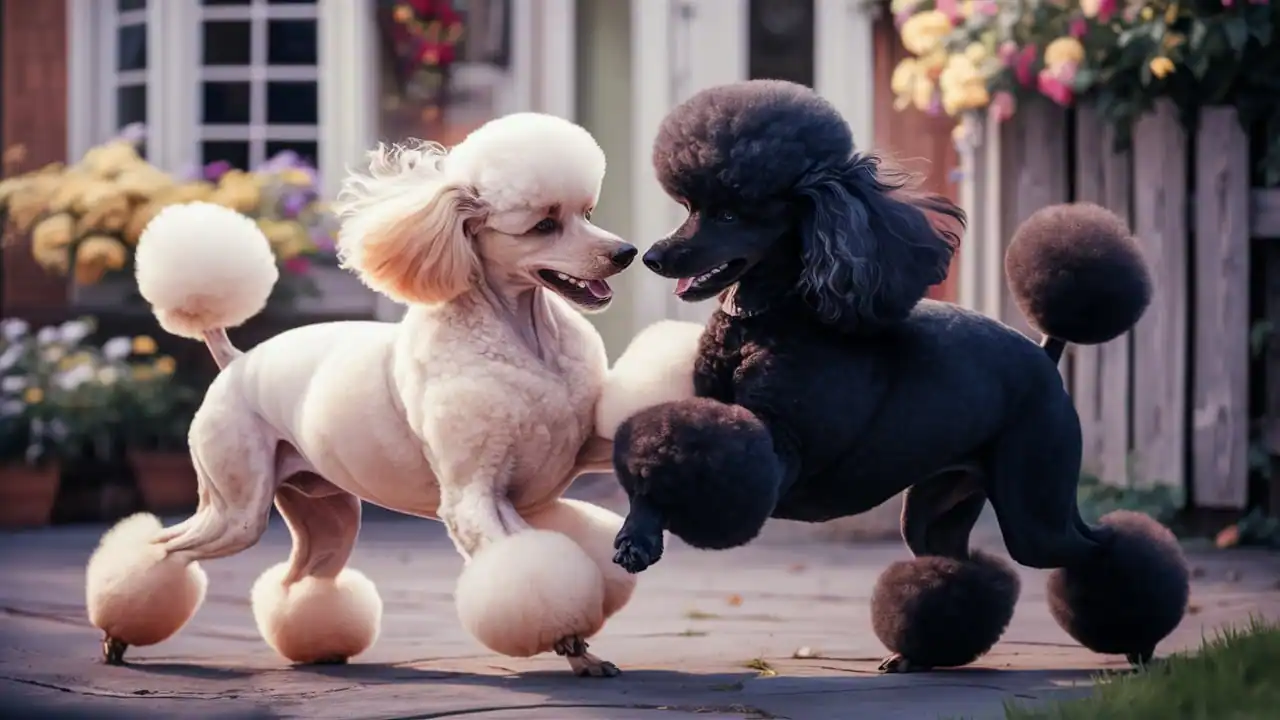As a poodle owner or enthusiast, understanding your dog’s unique coat is crucial for proper care and maintenance. One common question that arises is: Are poodles double coated? Let’s dive deep into the world of poodle coats and uncover the truth about these elegant canines’ hair.
The Short Answer
No, poodles do not have a double coat. They have a single-layer coat composed entirely of hair that continuously grows and sheds minimally. This unique characteristic sets them apart from many other dog breeds and contributes to their popularity among allergy sufferers and those who prefer low-shedding pets.
Understanding Poodle Coats in Depth
Structure: Poodles have dense, curly hair instead of fur. This single layer of hair grows continuously, similar to human hair. Dr. Jane Smith, a veterinary dermatologist, explains, “Poodle hair follicles are unique in that they have a longer growth phase compared to many other breeds, resulting in their characteristic coat. This extended growth phase is why poodles require regular haircuts, unlike dogs with typical double coats.”
The continuous growth of poodle hair means that without regular trimming, their coats can become quite long and prone to matting. This trait is what allows for the diverse and sometimes elaborate grooming styles poodles are known for.
Types of Poodle Coats:
- Curly Coat: The classic poodle look featuring tight curls. This coat type is dense and requires regular grooming to prevent matting. The curls can vary in tightness, with some poodles having looser waves and others having tight, corkscrew curls.
- Corded Coat: Less common, resembling dreadlocks. Created by carefully twisting and matting the hair into cords. This style requires significant maintenance and expertise to achieve and maintain properly. While striking in appearance, corded coats are less common in modern poodles due to the intensive care required.
Coat Colors and Variations: Poodles come in a wide variety of colors, including solid colors like black, white, brown, and apricot, as well as parti-colors (two or more colors) and phantoms (specific markings in a secondary color). The American Kennel Club recognizes over 10 different color varieties in poodles.
Characteristics:
- Hypoallergenic: While no dog is completely allergen-free, poodles are known for producing fewer allergens. This is primarily due to their minimal shedding and the fact that they produce less dander than many other breeds.
- Low-shedding: Poodles shed minimally compared to many other breeds. The hair they do shed often gets caught in their curly coat rather than falling onto furniture or floors, which contributes to their reputation as a clean breed.
- Versatile for styling: Their unique coat allows for various grooming styles, from practical to extravagant. Popular styles include the Continental clip, English saddle clip, and more casual puppy clips or sporting clips.
- Weather-resistant: Despite not having an undercoat, poodle coats can provide good insulation against both cold and heat when properly maintained.
Poodle Coat Care Requirements
Proper care is essential to maintain your poodle’s healthy, beautiful coat:
- Brushing: Daily brushing is crucial to prevent tangles and mats. Use a slicker brush or metal comb designed for curly coats. Pay special attention to areas prone to matting, such as behind the ears, under the collar, and in the armpits.
- Bathing: Bathe your poodle every 3-4 weeks using a gentle, dog-friendly shampoo. More frequent bathing may strip natural oils from the coat. Use lukewarm water and rinse thoroughly to prevent skin irritation.
- Professional Grooming: Schedule grooming appointments every 4-6 weeks for trimming and styling. Professional groomers can maintain your poodle’s desired look and address any developing coat issues.
- Ear Care: Poodles’ curly hair can grow inside their ear canals. Regular ear cleaning and hair plucking (if recommended by your vet) can prevent ear infections.
- Nail Trimming: Regular nail trims, typically every 2-3 weeks, are important for your poodle’s comfort and posture.
Expert Tip: Professional groomer Sarah Johnson advises, “Regular brushing not only prevents matting but also helps distribute natural oils throughout the coat, promoting overall coat health. It’s also an excellent opportunity to bond with your poodle and check for any skin issues or abnormalities.”
Poodle Coats vs. Double Coats
Understanding how poodle coats differ from double-coated breeds helps in appreciating their unique care needs:
- Grooming Needs: While poodles require regular maintenance, they don’t experience the intense seasonal shedding of double-coated breeds. However, their grooming needs can be more time-consuming due to the need for regular haircuts and daily brushing.
- Shedding Patterns: Poodles shed continuously in small amounts, similar to human hair. Double-coated breeds often “blow” their undercoat seasonally, resulting in periods of heavy shedding.
- Skin Protection: Poodles rely on their dense, curly hair for skin protection. Regular grooming is essential to prevent skin issues. Double-coated breeds have an insulating undercoat that provides additional protection against temperature extremes.
- Allergen Production: Poodles generally produce fewer allergens than double-coated breeds, making them a popular choice for allergy sufferers.
- Coat Regrowth: If shaved, a poodle’s coat will generally grow back to its original texture. In contrast, shaving a double-coated breed can permanently alter the coat texture and growth patterns.
FAQs About Poodle Coats
Do poodles shed at all?
While poodles are low-shedding, they do lose some hair. Regular grooming helps manage this minimal shedding.
Are poodles truly hypoallergenic?
Poodles are considered hypoallergenic, but no dog is 100% allergen-free. They produce less dander, making them a better choice for allergy sufferers.
How often should I trim my poodle’s coat?
Professional trimming every 4-6 weeks is recommended to maintain coat health and style.
Can I change my poodle’s coat type?
A poodle’s coat type is genetic and cannot be changed. However, different grooming styles can dramatically alter your poodle’s appearance.
Do poodle puppies have the same coat as adults?
Poodle puppies are born with soft, fluffy coats that transition to their adult texture around 9-18 months of age.
Conclusion
Understanding your poodle’s unique single-layer coat is key to providing the best care for your furry friend. While poodles don’t have a double coat, their distinctive hair requires regular attention to keep it healthy and beautiful. With proper grooming and care, your poodle’s coat will remain a stunning feature of this beloved breed.
Remember, every poodle is unique, so pay attention to your dog’s specific needs and consult with professional groomers or veterinarians for personalized advice on coat care. Whether you choose to keep your poodle in a classic show cut or a more practical trim, consistent care will ensure your poodle looks and feels their best.

